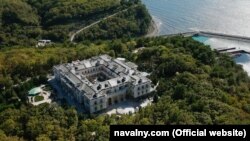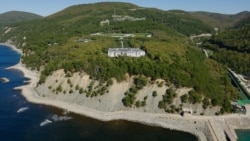On January 17, Russian opposition politician Alexey Navalny returned to Russia from Germany, where had received treatment after surviving an attempted assassination by poisoning that allegedly involved operatives of Russia’s Federal Security Service (FSB).
Immediately after arriving at Moscow’s Sheremetevo airport, Navalny was arrested for allegedly violating his parole. But even from jail, Navalny struck back at the Kremlin with a new video targeting Russian President Vladimir Putin.
The video, titled “Putin’s Palace: History of World’s Largest Bribe,” has been viewed on YouTube more than 92 million times since Navalny’s organization released it on January 19. It details what it claims is Putin’s history of corrupt dealings, starting from the end of his time with the Soviet KGB, to his work in the St. Petersburg mayor’s office and alleged involvement with criminal gangs, to his work in the Kremlin under Russia’s first elected president, Boris Yeltsin.
But the meat of the video is a never-before-seen examination of a massive palatial compound atop the cliffs of the Black Sea coast near the small Russian town of Gelendzhik. As all routes to this 7,000-hectare tract of land are closely guarded by the FSB, activists from Navalny’s group employed spy tactics to evade surveillance, filming the palace using a drone launched from a small inflatable raft off the coast.
The video describes the scheme by which some of Putin’s close friends built the palace for him, including one associate who served as its official owner for several years. While the story of the palace was first revealed by one of its planners who turned whistleblower in 2010, Navalny’s video details the complex web of ownership and business relations involved in building the palace. Navalny’s team also reconstructed the interiors of the palace using 3D modeling based on the structure’s plans. They were even able to source and price some its expensive custom-made furniture.
The Kremlin and even President Putin himself quickly denied and denounced the viral video. "We said that it wasn’t true and that speculations about President Putin’s relation to some facilities in Gelendzhik were untrue. It is just a lie,” presidential spokesman Dmitry Peskov said on January 22.
Putin himself then denied any ownership of the property, saying on January 25 that the palace “never belonged” to him, or any of his “close relatives.”
Those denials are misleading.
Although Putin may not officially own the palace complex, Sergei Kolesnikov, a businessman who was once part of Putin’s inner circle, revealed the Russian president’s connection to the palace back in 2010. Kolesnikov fled Russia after complaining about the palace to then-President Dmitry Medvedev in an open letter, and provided documents, plans, and other evidence to support his claims.
Kolesnikov also appears in Navalny’s latest video, detailing how Putin and his associates funneled money from a scheme that involved the purchase of medical equipment into what began as a project for a summer home in the area where the palace now stands.
Until 2011, the palace’s legal owner purportedly was Nikolai Shamalov, a Putin business associate. While Putin insisted that neither he nor any “close relatives” have ever owned the property, Shamalov’s son Kirill was married to Putin’s daughter, Katerina Tikhonova, from 2013 to 2018. Arguably he is not a “close relative” since there is no longer a family relationship after the divorce. Thus Putin’s denial may be technically truthful without actually refuting anything.
As the independent Russian news outlet Meduza reported on January 26, Alexander Ponomarenko, the Russian businessman Navalny’s investigation claims is the palace’s current owner, confirmed to the Russian newspaper Kommersant back in 2011 that he had acquired the property. Meduza cited Ponomarenko’s press service as saying that he withdrew from the project in March 2016 and that it had no information on the property's current status. On paper, the property is currently under the ownership of a company called Binom. As of late last year, Ponomarenko was Binom's sole legal owner.
Also on January 26, Peskov told reporters the property was owned by a businessman, but that the Kremlin had “no right to reveal the names of its owners.”
The secrecy and security surrounding the property appear to contradict the claim that the property is intended for the personal use of an anonymous “businessman.”
First, the property is under the FSB’s protection and was built under the supervision of the Federal Guard Service (FSO), which is responsible for the Russian president’s security. Airspace over the property is closed to air traffic, and the FSB told Navalny’s investigators they must stay at least one mile away from the coastline where the property is located.
Navalny’s video also shows satellite photos of the property, revealing a tarmac with three helipads. One of those helipads was recently replaced, and there have been rumors that an underground hockey rink was built in its place.
The security measures and FSB involvement make sense if the palace’s true owner is the Russian head of state.
The palace exposé is not the first involving assets allegedly held by third parties on Putin’s behalf. Similar claims came out the Panama Papers, a massive investigation into the records of a Panamanian law firm that revealed global money laundering and hidden offshore accounts and ultimately forced the resignation of two prime ministers, Iceland’s Sigmundur David Gunnlaugsson and the U.K.’s David Cameron. While Putin’s name did not appear in any of the Panama Papers records, the names of friends, associates, and relatives (including close relatives) of the Russian president did appear.
Among them was cellist Sergey Roldugin, a close friend of Putin who introduced the future Russian president to his now ex-wife Lyudmila and was godfather to Putin’s firstborn daughter Maria. Roldugin accumulated approximately $2 billion but was unable to explain the money’s origins, claiming it came from “donations” made by wealthy Russian businessmen. In 2019, Roldulgin was implicated in the “Troika Laundromat,” a $9 billion global money laundering scheme centered around Russia’s largest investment bank, Troika Dialog (now Sberbank CIB).
The Gelendzhik palace is not the only luxurious residence associated with Vladimir Putin. In 2012, Boris Nemstov, the Russian opposition leader assassinated within view of the Kremlin’s walls in 2015, published a report detailing Putin’s wealth. It listed 20 luxurious residences across Russia, including the Gelendzhik palace. Nemtsov’s report also listed aircraft, yachts, and even expensive wristwatches, including a Lange & Sohne model valued at $500,000.
Since Navalny’s January 17 arrest, protesters have taken to the streets in cities across Russia. An estimated 3,500 demonstrators were detained during unsanctioned marches on January 23.






